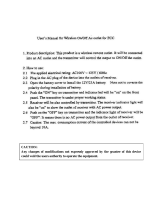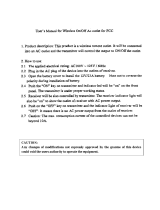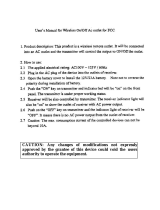Opus 600 – Contents
33
english
1. Safety and environment . . . . . . . . . . . . . . . . . . . . . . . . . . . . . . . . . . . . . . . . . . . 34
1.1 NE 600 diversity receiver . . . . . . . . . . . . . . . . . . . . . . . . . . . . . . . . . . . . . 34
1.2 S 600 / TS 600 transmitters. . . . . . . . . . . . . . . . . . . . . . . . . . . . . . . . . . . 36
1.3 Disposal . . . . . . . . . . . . . . . . . . . . . . . . . . . . . . . . . . . . . . . . . . . . . . . . . 36
2. NE 600 diversity receiver . . . . . . . . . . . . . . . . . . . . . . . . . . . . . . . . . . . . . . . . . . 38
2.1 Controls and indicators. . . . . . . . . . . . . . . . . . . . . . . . . . . . . . . . . . . . . . 38
2.2 How to connect the antennae . . . . . . . . . . . . . . . . . . . . . . . . . . . . . . . . 40
2.3 Where to place the receiver . . . . . . . . . . . . . . . . . . . . . . . . . . . . . . . . . . 40
2.4 Connections . . . . . . . . . . . . . . . . . . . . . . . . . . . . . . . . . . . . . . . . . . . . . . 40
2.5 How to operate the receiver . . . . . . . . . . . . . . . . . . . . . . . . . . . . . . . . . . 41
2.6 How to adjust the squelch . . . . . . . . . . . . . . . . . . . . . . . . . . . . . . . . . . . 41
2.7 Channel / frequency selection. . . . . . . . . . . . . . . . . . . . . . . . . . . . . . . . . 42
2.8 How to transmit the frequency to the transmitter / ACT function . . . . . . 42
2.9 How to install the receiver into a 19" rack . . . . . . . . . . . . . . . . . . . . . . . 42
2.10 How to connect and position remote antennae . . . . . . . . . . . . . . . . . . . 43
2.11 ZAS 800 antenna splitter . . . . . . . . . . . . . . . . . . . . . . . . . . . . . . . . . . . . 44
2.11.1 Controls and indicators . . . . . . . . . . . . . . . . . . . . . . . . . . . . . . . 44
2.11.2 Installation . . . . . . . . . . . . . . . . . . . . . . . . . . . . . . . . . . . . . . . . 44
2.11.3 General information . . . . . . . . . . . . . . . . . . . . . . . . . . . . . . . . . 45
3. S 600 handheld transmitter . . . . . . . . . . . . . . . . . . . . . . . . . . . . . . . . . . . . . . . . 46
3.1 Controls and indicators. . . . . . . . . . . . . . . . . . . . . . . . . . . . . . . . . . . . . . 46
3.2 How to insert the batteries / rechargeable batteries . . . . . . . . . . . . . . . . 46
3.3 How to operate the handheld transmitter. . . . . . . . . . . . . . . . . . . . . . . . 47
3.4 How to change the microphone capsule. . . . . . . . . . . . . . . . . . . . . . . . . 47
3.5 How to set the low-cut filter . . . . . . . . . . . . . . . . . . . . . . . . . . . . . . . . . . 48
3.6 Maintenance . . . . . . . . . . . . . . . . . . . . . . . . . . . . . . . . . . . . . . . . . . . . . 48
4. TS 600 beltpack transmitter . . . . . . . . . . . . . . . . . . . . . . . . . . . . . . . . . . . . . . . . 50
4.1 Controls and indicators. . . . . . . . . . . . . . . . . . . . . . . . . . . . . . . . . . . . . . 50
4.2 How to insert the batteries / rechargeable batteries . . . . . . . . . . . . . . . . 51
4.3 How to operate the beltpack transmitter . . . . . . . . . . . . . . . . . . . . . . . . 52
4.4 Adjusting the input gain . . . . . . . . . . . . . . . . . . . . . . . . . . . . . . . . . . . . . 52
4.5 AF connection . . . . . . . . . . . . . . . . . . . . . . . . . . . . . . . . . . . . . . . . . . . . 53
5. General instructions for all transmitters . . . . . . . . . . . . . . . . . . . . . . . . . . . . . . . 54
5.1 Battery change . . . . . . . . . . . . . . . . . . . . . . . . . . . . . . . . . . . . . . . . . . . . 54
5.2 Before the soundcheck . . . . . . . . . . . . . . . . . . . . . . . . . . . . . . . . . . . . . . 54
5.3 Positioning of transmitters if interference occurs. . . . . . . . . . . . . . . . . . . 54
5.4 What to do to avoid feedback . . . . . . . . . . . . . . . . . . . . . . . . . . . . . . . . 54
6. Trouble shooting . . . . . . . . . . . . . . . . . . . . . . . . . . . . . . . . . . . . . . . . . . . . . . . . 55
6.1 NE 600 diversity receiver . . . . . . . . . . . . . . . . . . . . . . . . . . . . . . . . . . . . . 55
6.2 Handheld and beltpack transmitter. . . . . . . . . . . . . . . . . . . . . . . . . . . . . 55
7. Maintenance . . . . . . . . . . . . . . . . . . . . . . . . . . . . . . . . . . . . . . . . . . . . . . . . . . . 56
8. Licensing . . . . . . . . . . . . . . . . . . . . . . . . . . . . . . . . . . . . . . . . . . . . . . . . . . . . . . 56
9. Components . . . . . . . . . . . . . . . . . . . . . . . . . . . . . . . . . . . . . . . . . . . . . . . . . . . 56
10. Optional accessories. . . . . . . . . . . . . . . . . . . . . . . . . . . . . . . . . . . . . . . . . . . . . . 57
11. Technical specifications. . . . . . . . . . . . . . . . . . . . . . . . . . . . . . . . . . . . . . . . . . . . 58
EC Declaration of Conformity . . . . . . . . . . . . . . . . . . . . . . . . . . . . . . . . . . . . . . . . . . 121






















